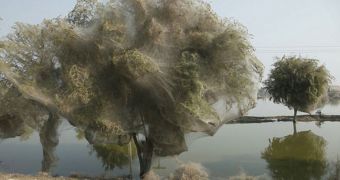During the second half of 2010, Pakistan was severely affected by floods. The effects of the disastrous events were seen even from satellites and astronauts in space, but some of them have eluded detection until recently. Such is the case of tree-based spider colonies.
As 20 percent of the country's territory became submerged underneath the roaring waters, some 20 million people were uprooted and affected. But so were millions upon millions of spiders, who were happily getting on with their lives before the floods.
When the waters came, many of them found refuge in trees that withstood the fury of the floods. Over the coming months, the arachnids developed out-of-this-world colonies, covering entire trees in webs.
This gives trees in certain areas of Pakistan an eerie, alien appearance. Experts say that the creatures were forced to learn to coexist in order to survive, even if they belonged to different species.
One of the reasons why things got so desperate for the spiders was that the waters brought on by the floods took forever to recede to their original river beds. This meant that the arachnids could not climb down from their safe havens.
As the months passed, the number of webs that spun increased considerably, as new generations were added to the equation. Eventually, entire trees became covered in webs from top to bottom.
But the effect was not extended to trees exclusively. Bushes, tall grasses and any other type of visible vegetation were also covered by massive webs, spun by millions of spiders starving to support their populations and species.
But experts say that this has a positive effect as well. As flood waters endured, and remained stagnant, there was a considerable fear among Pakistani authorities that malaria would spread in the general population, due to the massive numbers of mosquitoes that could develop in the water.
But that didn't happen. The massive webs the stranded spiders spun were apparently too appealing to millions of mosquitoes, that met their end in the trap-trees the arachnids set up for them. The number of malaria vectors was therefore significantly reduced.
This helped the Pakistani government take its mind of public heath, and focus instead on reconstruction. However, experts say that many years will pass until the areas that were worst-hit by the flood will recover entirely, Wired reports.
It will also be interesting to see if spiders climb down from the trees they squatted once waters recede, say scientists. Such an event could be a wonderful catalyst for a bout of evolution, that may see many spider species in the area moving to trees in large numbers, and learning to cooperate.

 14 DAY TRIAL //
14 DAY TRIAL //